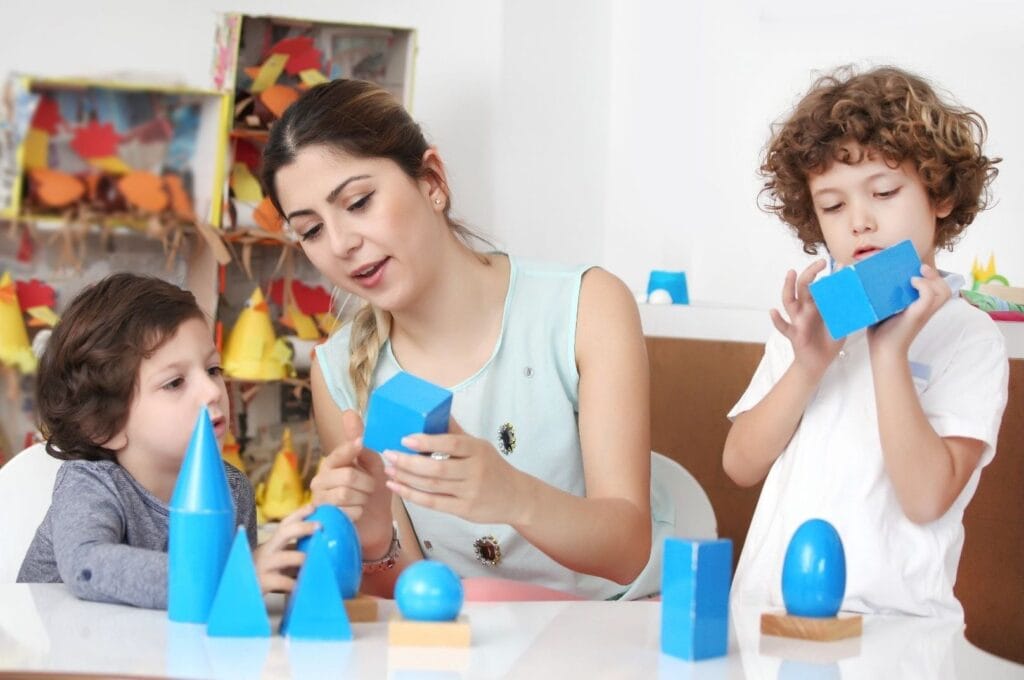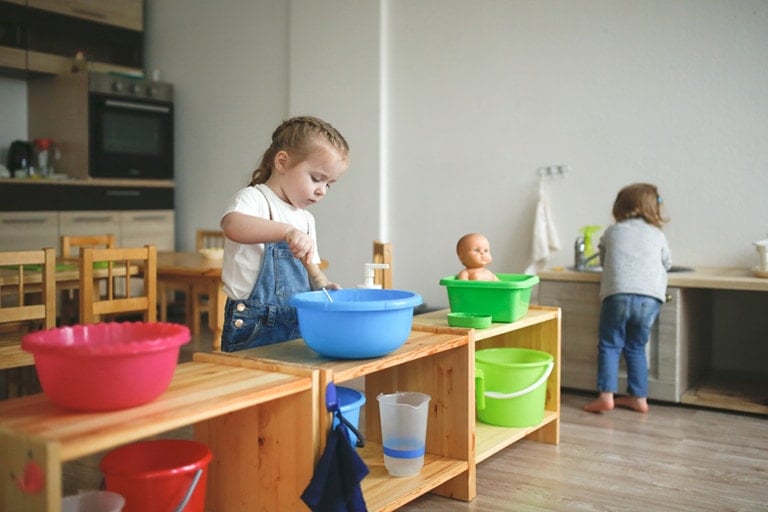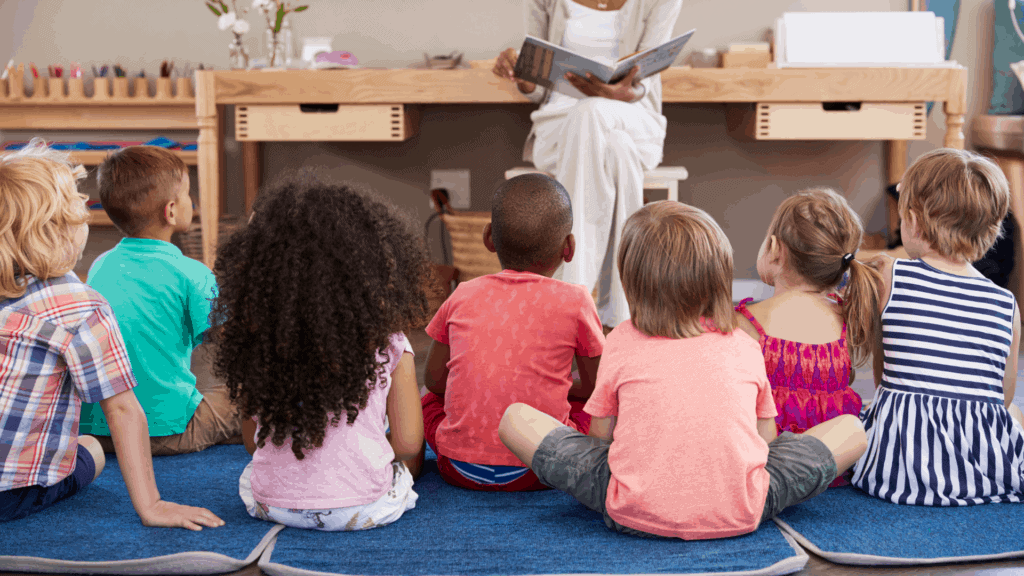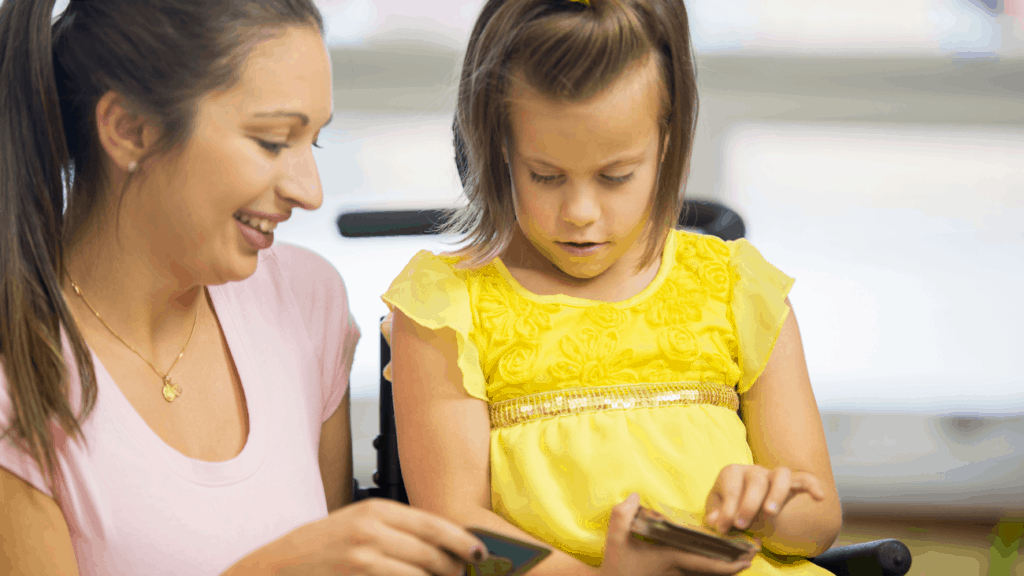One of the most important decisions parents make for their children is the type of education they will receive, and the options seem endless. If you’re looking into schooling options, you’ve probably heard about
Montessori schools are schools that use the educational philosophy espoused by Maria
However, there is a lot more than this that goes into making a successful
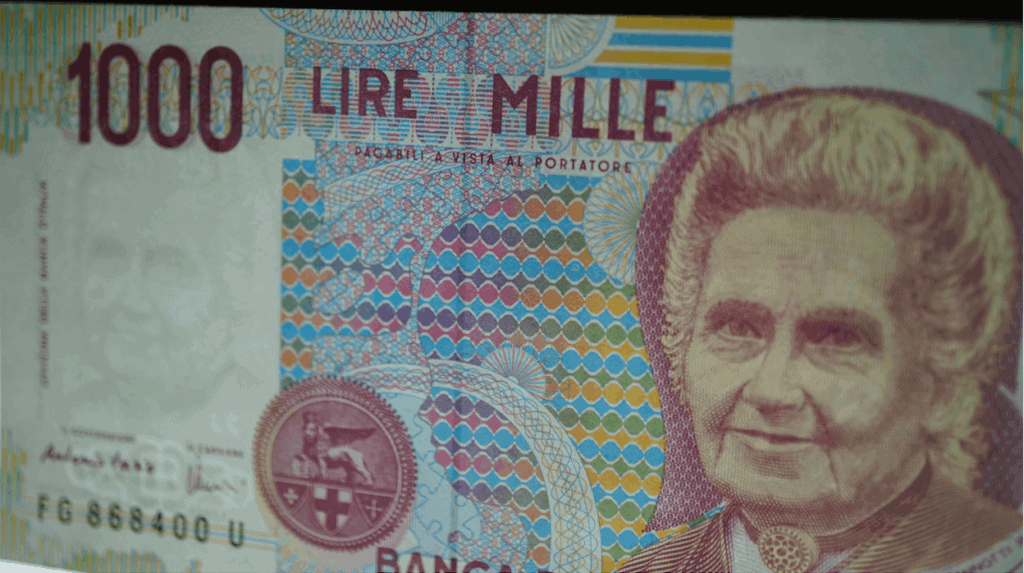
Who was Maria Montessori ?
You can’t talk about
At this school, called the Children’s House,
She wrote fifteen books that describe her philosophy in detail. While a little dated, they are still relevant and used by
- The Montessori Method: Scientific Pedagogy as Applied to Child Education in the Children’s Houses
- Dr.
Montessori ‘s Own Handbook - The Advanced
Montessori Method - The Absorbent Mind

Maria Montessori was an amazing woman and educator. She accomplished much despite the limiting gender stereotypes of the time and was active in the field of education research until her death at age 81.
What are Montessori Values?
So, what values did
Learning Should be Child-Led
Easily the most important part of
In the proper environment, all students will seek out opportunities to learn and develop their faculties. This simple idea is where the
Students are Individuals
Montessori also believed in treating children as individuals and with the deepest respect. Children should not be patronized or barred from doing activities (like preparing their own snacks) just because they are children.
Additionally, she championed the idea that children develop at their own pace, and that their natural speed is the best pace. Learning should never be forced upon the child.
The Whole Child Should be Developed
Many educational philosophies that come out of the Progressive Era believed in teaching the WHOLE child.
Because of this, you will see many
Hands-On Experience is How We Learn
Experience is everything in the
The Teacher is an Observer and Researcher
The teacher’s role in the Montessori classroom is to observe students and analytically create lessons and curriculum that responds to the students’ needs.
The teacher may do some whole class lessons, but most lessons occur one-on-one or in small groups. Even within the lesson, the teacher does not take an active role. They may model the activity or ask questions, but the child is given space to learn through experience.
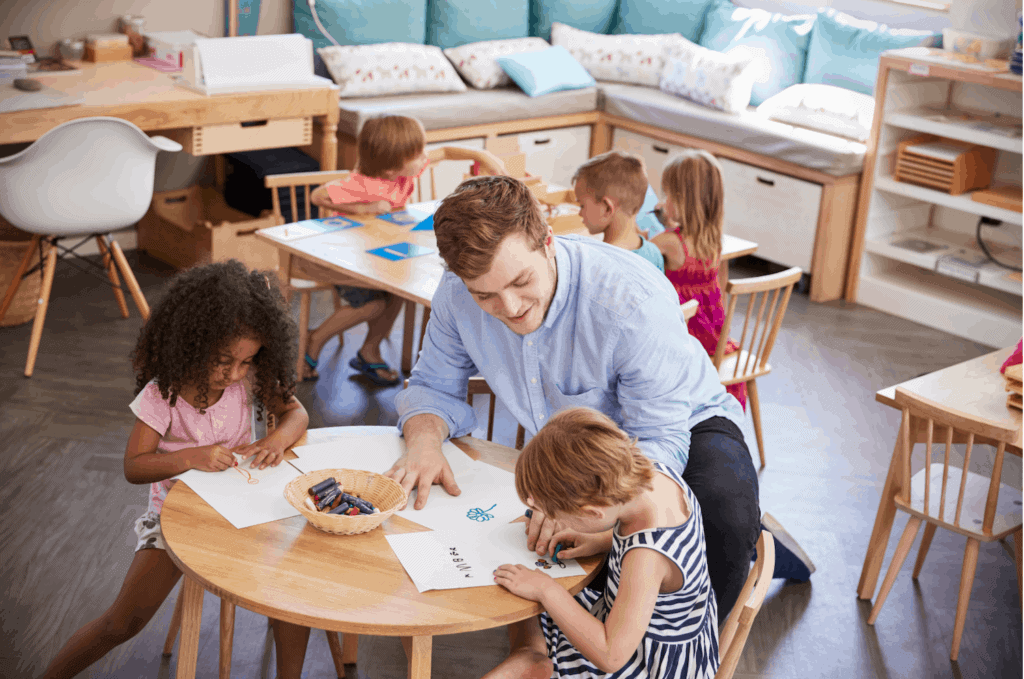
What Subjects are Taught in Montessori Schools?
All of the subjects you’ve come to expect in a typical school are covered within a
Students may still have “specials” or designated times to spend with certain expert teachers (like art, music, or gym), but if not, rest assured that these topics are still integrated into the curriculum.
But
- Practical life: Examples of this include tidying up, washing hands, cleaning objects, dishwashing, putting on a coat, sewing, cooking.
- Sensorial learning: This kind of learning focuses on cultivating a student’s ability to discriminate between sensory experiences like hot and cold, but also more refined experiences such as differentiating the call of different birds.
- Mindfulness: Mindfulness is one of the ways
Montessori teachers help students develop their emotional capacities. This might include meditation, yoga, or other methods of becoming calm. - The student’s interests: Especially as
Montessori students get older, they will be encouraged to explore their own interests. They may start their own business, organize a food drive, or put on a play about someone from history.
How these are integrated into the curriculum and to what extent depends on the age of the child. For example, leadership may be a big part of a student-led high school curriculum, but in a preschool, this isn’t quite as prevalent.
You could argue that all of these subjects are taught within traditional schools, and you’d be right. The main thing that sets the
Through these subjects,
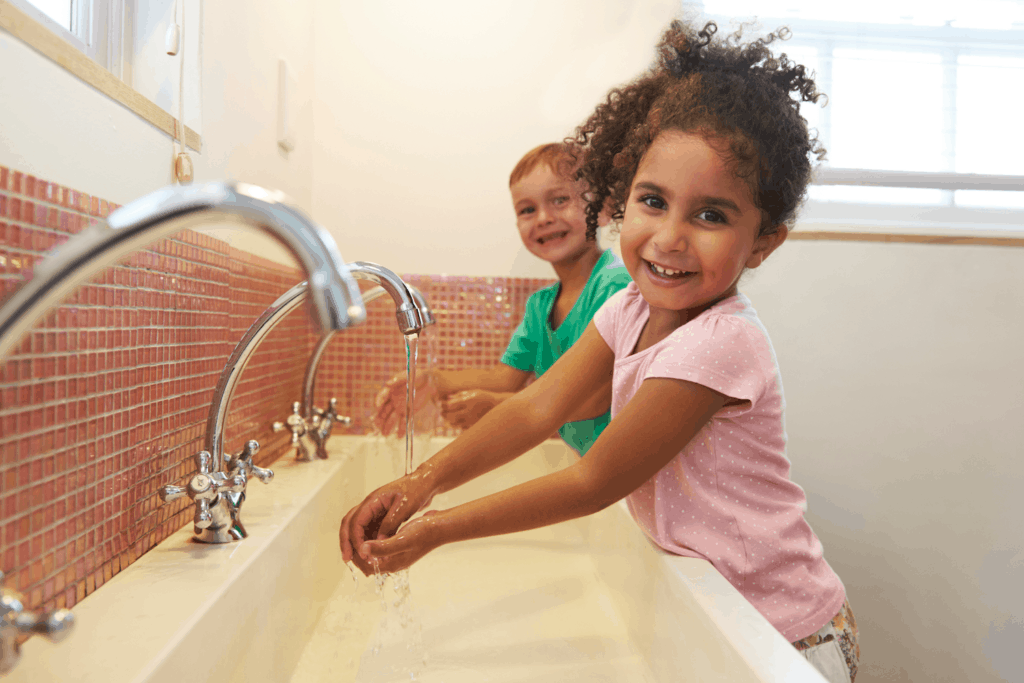
Hallmarks of a Montessori School
Maria Montessori was very detailed about her approach to education, and so when you walk into a
The Prepared Environment
The prepared environment is what Maria
What does a
- Student height sinks and counters
- An area for students to prepare their own snacks or meals
- Prepared learning activities within reach of the child, often on low shelves
- Several areas for students to work like tables, cushions, and rugs
- Orderliness, purpose, and simplicity
- Space so that students can freely move around
You can’t do
The Work Cycle
The work cycle is another essential to the
Without this 3-hour block of time dedicated to their independent learning, students do not get to have the satisfaction of completely exhausting their learning.
Montessori observed that students started the work cycle by selecting familiar activities, and then after a brief period where the student seems tired, they select more challenging work. By the end of the work cycle, students should have been able to complete the challenging activity they set out to do. They may even have completed it multiple times until they naturally tire of it.
The lack of interruptions during the work cycle allows students to develop their attention span as well.

The Three Period Lesson
The three-period lesson is a method of conducting a lesson that
- The first period is the naming stage. During this part of the lesson, the teacher would name an object or concept for a student. For example, the teacher would hold up a card with a picture of an island and say, “This is an island.” Then they might hold up a picture of a peninsula and say, “This is a peninsula.”
- The second period is the recognition stage. In this period, the student would be able to point to the object. The teacher would say, “Show me the island.”
- The third period is the remember stage. The student must be able to recall the word and the meaning of the word. The teacher would hold up the picture of the island and say, “What is this?”
Most
Self-Assessment
Self-assessment is important to the child-led learning experience. This doesn’t mean that the teacher does nothing to assess the student’s learning and progress. Much of the teacher’s class time is spent observing and assessing students.
What it does mean is that the student is not privy to the teacher’s assessment. The student assesses their own work.
When a teacher shows that they believe a student has done something wrong, it takes away some of their independence and makes them strain to learn something that they wouldn’t normally apply themselves to, which isn’t conducive to a child-led learning experience.
A teacher may guide appropriate behavior or remove activities that are being used destructively, but they do not praise or admonish students for correct or incorrect responses.
Most activities are designed to self-correct, which means the activity itself tells the student that they are not going in the right direction.
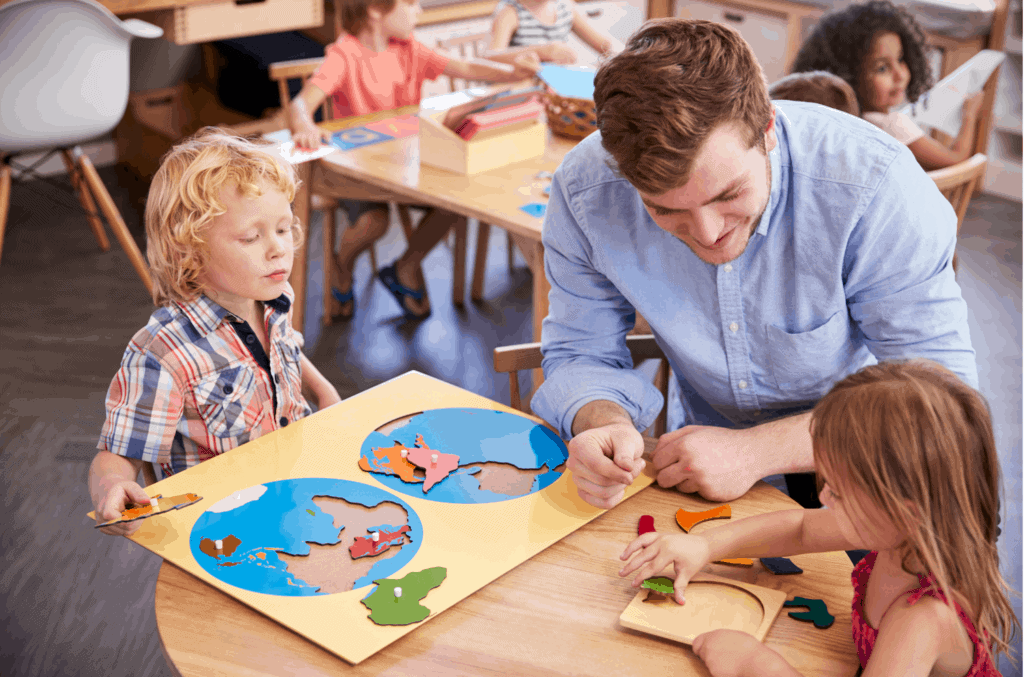
Teaching with Truth
One of the things that Maria
She also observed that when children were given a choice between pretend play and the real activity, they always chose to do the real activity. For example, a child would prefer to prepare their lunch in a real kitchen with real food than use a play kitchen with play food.
Because of this, she advocated for ditching imaginative play and instead giving children the opportunity to do the real task and work with the real world. This is seen as an act of respect and nurturing.
This does not mean that children don’t get to be creative. They have opportunities to make art, write stories, and create music in meaningful ways.
Mixed Age Classroom
Montessori classes have children of multiple ages in them! It varies from school to school, but for the most part, schools group students into groups that span three years. This is what this looks like:
- Ages 3-6
- Ages 6-9
- Ages 9-12
- Ages 12-15
- Ages 15-18
The mixed-age classroom offers many advantages, like opportunities for leadership and letting students progress at both faster or slower rates without stigma.
Natural Materials
You’ll find that
What you won’t see is a lot of plastic items or brightly colored items that are bright without purpose. You also won’t find a lot of technology. Clearly, Maria
Because of this,
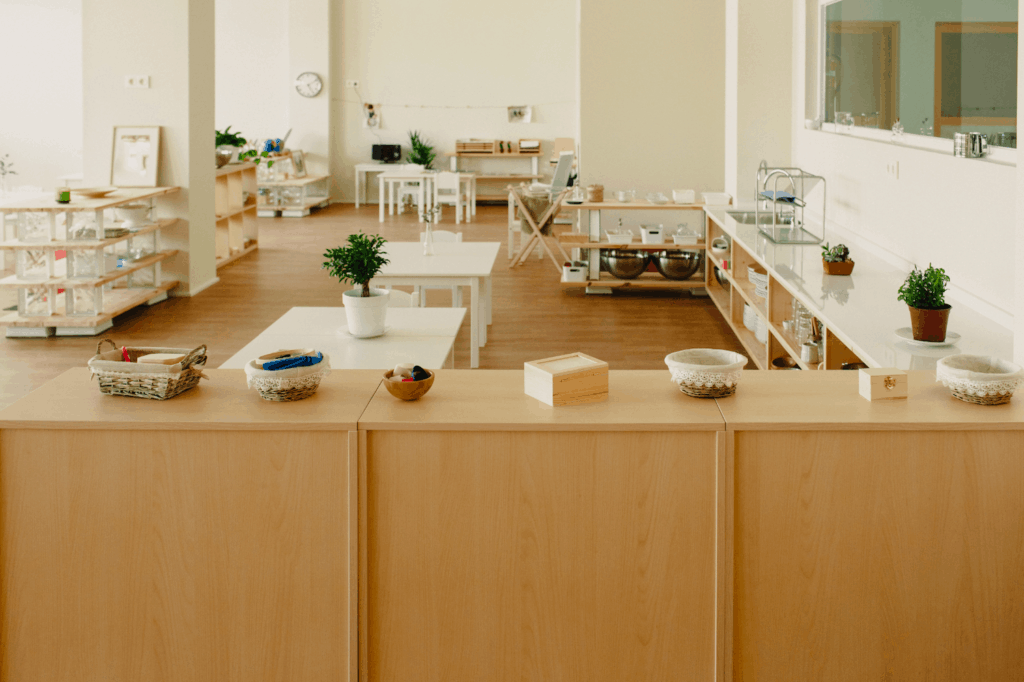
Writing Comes First
That’s right. Montessori schools teach writing before they teach reading, and it works amazingly well, and the most faithful
Montessori educators do this because it works. Students pick up cursive writing much easier than print writing, and once they’ve learned to write the letters and build words with the sounds the letters make, reading is a cinch.
Most
What does a Typical Montessori Day Look Like?
What a typical day looks like for a
Let’s take a look at what you can expect based on the age of your child.
A Typical Day in a Montessori Preschool
The exact order of these elements may vary slightly depending on the age of the children and the specifics of the program, but most preschools will have each of these components during the day.
- The work cycle. The day typically starts with a 1-2 hour work cycle. Students come in and settle into work right away. The work cycle is the most important part of the day. It starts right away to prevent interruptions.
- Snack Time. After the work cycle, students may have a snack or be encouraged to use the bathroom.
- Rest/Circle Time. Most teachers find that this is the perfect time for some rest since students were working hard during the work cycle. In
Montessori , rest is associated with group time or circle time. The student can relax while stories are read, and songs are sung. This is usually about 30-45 minutes. - Outdoor Time. At this age,
Montessori puts emphasis on movement. Students get ample outdoor time or opportunities to move their bodies in big ways. - Lunch. After all that moving around, students are ready to enjoy lunch. Even in preschool, students may help set tables and prepare the classroom for lunchtime.
- Quiet time. Students tend to fall into a lull after all the activity of the day. Quiet time might be a nap, storytime, or time for mindfulness exercises.
- Second outdoor time. Some teachers like to include a short time outdoor right before dismissal.
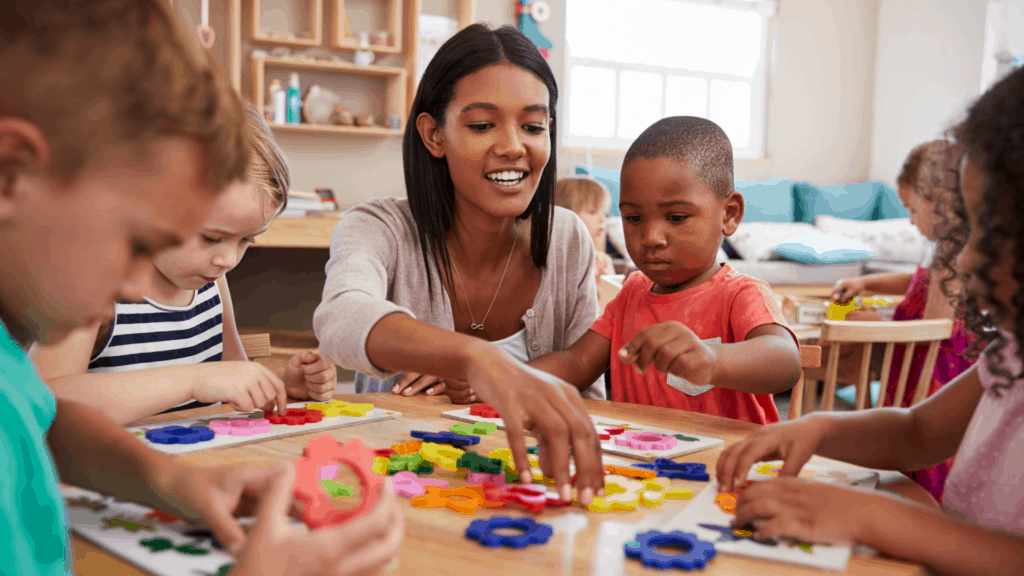
A Typical Day in an Early Elementary Montessori School
Early elementary includes some of the same elements from the preschool classroom, but have a bit more structure and more time for learning, which is developmentally appropriate at this age.
- The work cycle. Early elementary educators also tend to start the day with a 2-3 hour work cycle. Students come in, and the students put their things away and get started on the serious work of learning.
- Group time. It might not be called circle time, but it’s the same idea. It is time for the whole class to come together. There may be announcements, sharing, or group lessons. Typically this is only 15-20 minutes at this age.
- Outdoor time. Time for movement is still important at this age, but the amount of time is usually a little less than in preschool. Students may spend 45 minutes to an hour outside.
- Lunch. Students become increasingly involved in setting up lunch and cleaning up after lunch.
- The second work cycle. The main difference between early elementary and preschool is that students have a second work cycle. Because
Montessori is child-led, if a student still needs quiet time or rest, they can choose to do that instead, but most are ready and enjoy a second work cycle. - Second outdoor time. At this age, many educators prefer to end the day with outdoor time. This gets the children ready to go, and parents can pick up their children as they wish.
A Typical Day in a Late Elementary Montessori School
The late elementary
- The work cycle. Once again, the day begins with the serious work of learning. This time is usually used for individual work.
- Group time. The class comes together for whole class lessons or announcements. This is typically 20-30 minutes or longer if there are lessons.
- Lunch. Students are completely independent at this stage.
- Second work cycle. At this age, students grow more social, and they may begin working in small groups more often. The second work cycle is usually used for projects or larger group lessons. The second work cycle does not always happen every day, especially if students do specials or students require specialized education services.
- Outdoor time. The day still ends with some outdoor time, usually about 30 minutes to an hour.
We haven’t included information on what a day looks like at the secondary level because of how schools interpret the

The Science Behind Montessori
Montessori may have started her Children’s House over 100 years ago, but she was precise and scientific in her study of child development. All of the recommendations she made were based on her observations, and through pedagogical experiments she conducted with the help of children.
The Montessori method is rooted in science. So, it shouldn’t be surprising that researchers continue to show that students do well in
- Lillard, Angeline S Frontiers in Psychology October 2017— This study compares academic learning in two preschools. It found that
Montessori students did better than their peers in a traditional preschool in academic areas, although there was no difference in soft skills like problem-solving. - Lillard, Angeline S Journal of School Psychology June 2012—This study found that a classic
Montessori approach worked better in preschools than a lower fidelity approach and a traditional approach. Preschool students in the classicMontessori preschool had greater gains in executive function, reading, vocabulary, math, and social problem-solving. - Lillard, Angeline S Journal of Montessori Research May 2016—This study looked at the influence of non-Montessori materials in the
Montessori classroom. When non-Montessori materials were completely removed from the classrooms, students made great gains. - Besancon, Maud Learning, and Individual Differences 2008—This study found the
Montessori students at the age of 12 did better at creative thinking tasks than traditionally schooled students.
What these studies show when looked at together is that
However, what is clear is that
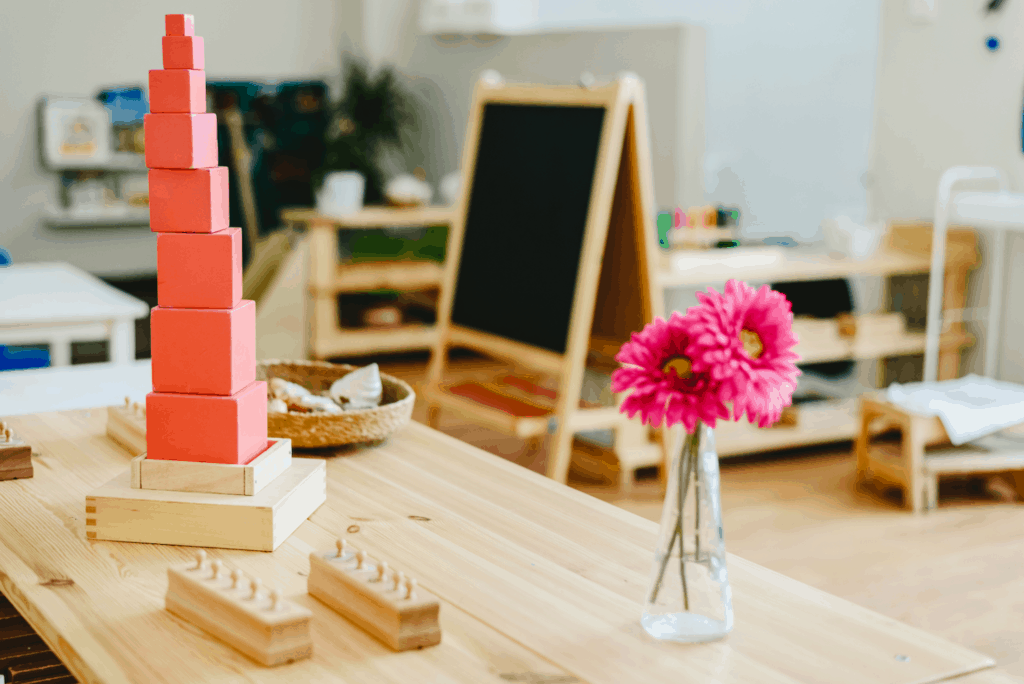
What to Look for in a Montessori School
The best Montessori schools are those that follow Maria
But we can’t dance around the fact that some educators equate a
Here’s what you should look for in a
- The prepared environment. The classroom should be inviting, orderly, and peaceful, and the students should be able to go about their day independently.
- A schedule. Teachers should have a schedule that includes at least one work cycle. Its length should be developmentally appropriate. It should also include plenty of time outdoors for young children.
- Reduced or no technology.
Montessori classrooms should not have computers, tables, or televisions, especially in the early grades. In third grade, typing instruction might begin, and you may see a computer. - No pretend play toys. The presence of pretend play toys in the classroom is a sign that a teacher is not following
Montessori closely. There’s nothing inherently evil about pretend play toys, but students prefer doing the real task over pretending. Instead of pretending to wash dishes, they’re given the opportunity to actually wash dishes! If pretend play toys are prevalent, it may mean teachers aren’t allowing students the freedom to participate in the real task. - No rewards. True
Montessori educators believe that learning itself is enough of a reward for students. Including rewards in the classroom may lead students to feel they need an external reward for learning. - An observant, flexible teacher. If you have the opportunity to observe a work cycle, take it. You should see a teacher that is observing their students, giving individual lessons, and gently guiding students without insistence.
- Accreditation. The American Montessori Society accredits
Montessori schools. This doesn’t mean that an unaccredited school is terrible, but accreditation goes a long way toward showing that the educators are following Montessori principles. Click here to learn more aboutMontessori school accreditation and licensure.
What is Montessori About?
Montessori is about developing independent, confident, life long learners that have the social, emotional, practical, and cognitive skills required to care for themselves and look after their community. This is the aim of many methods of educating youth, but
It is no surprise that the practices outlined over a hundred years ago are still effective for teaching children today.
Read more about if Montessori school is right for every child, or check out our article on


